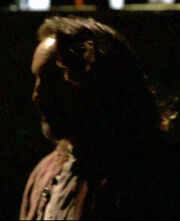| This article has been marked for merging It has been suggested that this article be merged with [[Archetype / the shadow]] - Discuss |
| Literary techniques |
|---|
| Comparative: Irony • Juxtaposition • Foreshadowing Plotting: Cliffhanger • Plot twist Stock characters: Archetype • Redshirt • Unseen character Story: Flashbacks • Flash-forwards • Flash sideways • Framing device • Regularly spoken phrases • Symbolism • Unreliable narrator |

Jacob, the prototypical unseen character is shown extremely briefly in shadow
"Unseen character" is a literary term for a certain type of stock character. An unseen character has the following characteristics:
- Usually not shown to the audience, but may be shown in shadow, or only from the neck down
- Is a recurring character, and important to the plot
See also: Unseen character at Wikipedia
In Lost
Jacob
Jacob is the prototypical unseen character. He is introduced to the audience as only "Him" in "Dave", which made the character not only unseen, but also unnamed. The character continues unnamed until "I Do", when Danny mentions "Jacob's list". Many characters and the audience question the very existence of the character until Jacob is finally revealed in a split second of shaky camera motion in "The Man Behind the Curtain".
The Monster

The audience sees the Monster indirectly, only through the eyes of John Locke
Although not depicted as a human character, the Monster is the typical unseen character during the entirety of Season 1:
- The Monster knocks down trees, and makes a mechanical-like noise, but is not seen by the survivors, or by the audience. It later figures as an important part of the Island when it brutally kills the Pilot. ("Pilot, Part 1")
- Locke sees the Monster, but the audience is only allowed to see through the Monster's eyes. ("Walkabout")
- Some of the action in Boone's vision is shown from the perspective of the Monster. ("Hearts and Minds")
- The Monster is shown as wisps of smoke, but only briefly. ("Exodus, Part 2")
In Season 2, the Monster is finally revealed to both Eko and the audience in "The 23rd Psalm".
See also
- Category:Unseen Characters - A list of characters mentioned in Lost, but never shown. Note that many of these are not true "unseen characters" as defined in this article.
